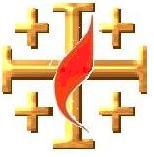LUTHER 1527 The Council of Nicaea, 325


LUTHER 1527
However, in order to strengthen our people, I shall go on and show that the fanatics’ reasons and arguments are worthless, and shall prove to the point of superfluity that it is contrary neither to Scripture nor to the articles of faith for Christ’s body to be at the same time in heaven and in the Supper. I shall do this even though I do not owe it to the fanatics; rather, they are under obligation to prove that it is contrary to Scripture, and they cannot do it, as we have said. If I have proved this, however, then the words, “This is my body,” should be allowed to stand and remain just as they read. -Martin Luther
The Council of Nicaea, 325
The two other points on which the council of Nicaea decided,
the Easter question and
the Meletian schism, have been already spoken of in their place.
The council issued twenty canons in reference to discipline.
The creed and the canons were written in a book,
and again signed by the bishops.
The council issued a letter to the Egyptian and Libyan bishops as to the decision of the three main points;
the emperor also sent several edicts to the churches,
in which he ascribed the decrees to divine inspiration,
and set them forth as laws of the realm.
On the twenty-ninth of July,
the twentieth anniversary of his accession,
he gave the members of the council a splendid banquet in his palace,
which Eusebius (quite too susceptible to worldly splendor) describes as a figure of the reign of Christ on earth;
he remunerated the bishops lavishly,
and dismissed them with a suitable valedictory,
and with letters of commendation to the authorities of all the provinces on their homeward way.
HISTORY OF THE CHRISTIAN CHURCH Schaff Volume 3 NICENE AND POST-NICENE CHRISTIANTY A.D. 311-600
(Page 630)

0 Comments:
Post a Comment
<< Home